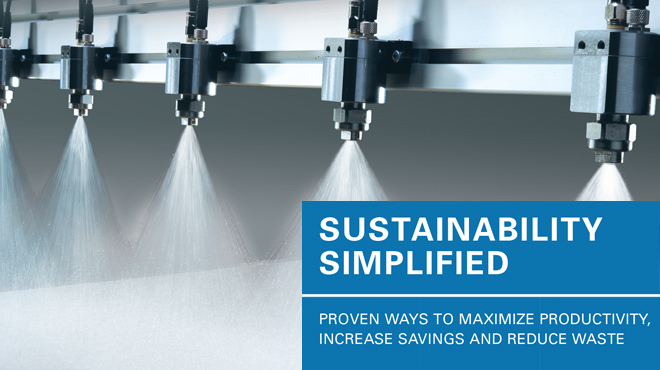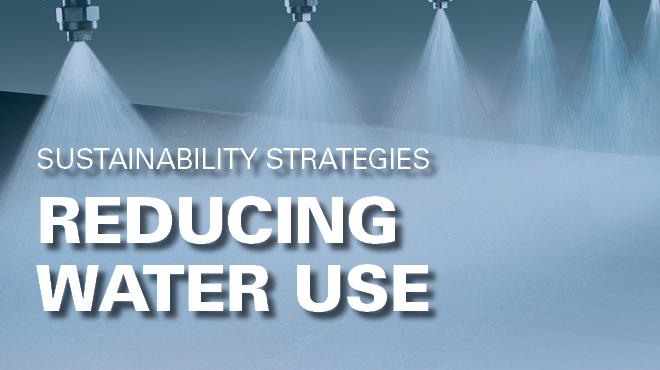Sustainability Strategies
Sustainability Strategies
The most common sustainability goals are listed below. You'll find ways to achieve those goals using spray technology we offer.
GOAL: REDUCE WATER USE
DID YOU KNOW?
There’s a perception that more flow is better. People tend to size up nozzles to be safe without realizing how much water may be wasted. Significant savings can come from small changes like selecting the right size nozzle for each application. That simple step can directly impact the amount of water you use for processing, manufacturing and sanitation throughout your plant.
POTENTIAL STRATEGIES
-
Properly size spray nozzles and manifolds
-
Use the most efficient nozzle for the operation and make sure it is positioned correctly
-
Use high impact nozzles to increase cleaning effectiveness and reduce cleaning time
REAL-WORLD RESULTS
Spraying Systems Co. helped a snack food producer reduce water consumption by more than 80% simply by switching to lower flow rate nozzles. This saved US$3 million and more than 500 million gallons (1,892,706 kiloliters) annually.
GOAL: REDUCE ENERGY USE
DID YOU KNOW?
Using less water can have a big impact on energy use. The energy required to operate pumps, heat water and treat wastewater decreases proportionally as water use is reduced. Another often overlooked way to reduce energy is to evaluate operations that use compressed air. Alternatives exist and can provide quick payback.
POTENTIAL STRATEGIES
-
Use properly sized nozzles to minimize pump size
-
Use nozzles that eliminate the need to heat the solution being sprayed
-
Use hydraulic atomizing nozzles instead of air atomizing nozzles for cooling and humidification
-
Replace open pipes with air nozzles
-
Replace compressed air nozzles with blower-powered air knives
-
Use other fluids for atomization instead of compressed air such as steam or hydrogen
-
When air atomizing nozzles are required:
-
Use high-efficiency air atomizing nozzles
-
Use automatic air atomizing nozzles to provide positive air and liquid shut-off
-
Use air and liquid regulators to optimize fluid use
-
REAL-WORLD RESULTS
Spraying Systems Co. helped a can manufacturer reduce energy use by nearly 5,500,000 kWh, a savings of US$500,000 annually.
GOAL: REDUCE CHEMICAL & INGREDIENT USE
DID YOU KNOW?
Over-application and misting are the primary causes of coating waste. Many manufacturers can reduce the use of costly coating by as much as 70% with advanced spray technology. It delivers exceptional precision that saves chemicals and money.
POTENTIAL STRATEGIES
- Implement Precision Spray Control (PSC) to eliminate over application
- Heat applicable solutions to make them sprayable
- Use timing/sensor control to spray only when needed
REAL-WORLD RESULTS
Spraying Systems Co. helped a fiber producer eliminate overspray. They saved US$1.4 million annually by dramatically decreasing the use of surfactant.
GOAL: IMPROVE WORKER & FOOD SAFETY
DID YOU KNOW?
Optimized spray technology can help reduce or eliminate risks to worker safety. Proper application of fluids can eliminate slip hazards and improve air quality. Automating application of fluids can make it unnecessary for workers to interact with dangerous equipment and chemicals. Automation also ensures consistent application of fluids and reduces the risk of product contamination and recalls.
POTENTIAL STRATEGIES
-
Prevent excess fluid from accumulating/pooling on equipment and floors using Precision Spray Control (PSC) technology
-
Reduce misting by using nozzles that minimize or eliminate compressed air consumption
-
Replace air atomizing nozzles with hydraulic atomizing nozzles
-
Automate cleaning operations that require workers to enter tanks or vessels or climb equipment
-
Use moisturizing nozzles to prevent and suppress dust
-
Protect against pathogens through consistent and uniform application of sanitizers, antimicrobials and mold inhibitors on equipment and food products with PSC
REAL-WORLD RESULTS
Spraying Systems Co. helped a commercial bakery overcome worker safety issues caused by overspray and misting. Our solution decreased oil use by 50% for a savings of US$1.3 million per year and worker safety was greatly improved. OSHA tests validated a 90% reduction in airborne pollutants and slippery floors were eliminated. Reject rates also decreased substantially.
GOAL: DECREASE WASTE & SCRAP
DID YOU KNOW?
A surprising number of quality problems can be traced back to cleaning, coating, cooling and lubricating operations. However, it may not be obvious which part of the process created the issue. Spray technology can be a contributing factor. For example, rust problems can stem from improper application of corrosion inhibitors. Equipment damage can be caused by ineffective gas cooling. Reduction in product shelf life can occur due to variations in antimicrobial interventions. Using advanced spray technology can help ensure proper application to prevent process waste and quality issues.
POTENTIAL STRATEGIES
-
Eliminate uneven and inconsistent application with Precision Spray Control (PSC)
-
Automate processes that use manual labor for cleaning or coating to eliminate variations in water/chemical consumption and application weights and rates
-
Ensure nozzles are operating at acceptable pressures and flows. If not, changes in drop size, spray angle and capacity may occur and have a negative impact on product quality
REAL-WORLD RESULTS
Spraying Systems Co. helped a metal processor apply the proper volume of oil. By maintaining a precision spray, the processor eliminated rework of 960,000 pounds of strip each year.



